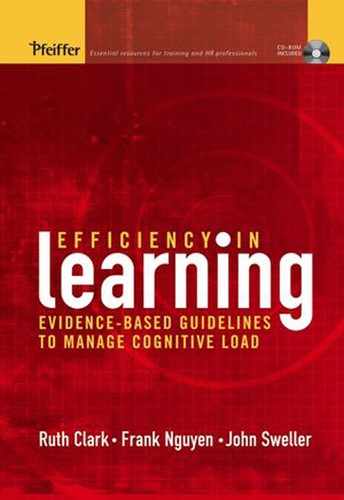The biggest expense in organizational training today is the time the participants spend away from the job. Instructional professionals can maximize a return on investment in training by developing efficient learning environments that result in faster learning, better learning, or both. Unlike other resources for training tips and techniques, we offer evidence-based guidelines based on over twenty-five years of experimental research on cognitive load theory. Whether you are a classroom or online instructor or a designer of training for classroom or multimedia delivery, by reading this book, you will learn how to create efficient instructional environments and why they work.
By applying the guidelines in this book, you can create efficient instructional environments. Specifically you will learn the most efficient ways to use the three fundamental tools available to all training professionals: visuals, written text, and audio. Whether you are working in the classroom or in print, synchronous, or asynchronous media, you will be able to apply our guidelines to your lesson presentations, handouts, reference guides or e-learning screens. You will be able to accelerate learning by avoiding the pitfalls of split attention and redundancy in your presentation modalities or content. You will see how to save learning time and improve learning by reducing practice exercises. Because we summarize the research evidence as well as the psychological reasons for our guidelines, you will know not only what to do but why you are doing it so you can apply these instructional principles to a variety of contexts as well as explain your instructional decisions to your colleagues and clients.
This book is divided into five parts. In Part I we introduce cognitive load theory, which is the basis for all of our guidelines. Part II offers you specific guidelines and examples for ways to avoid irrelevant cognitive load that burdens memory but does not contribute to learning. Part III shows you how to use the memory capacity you have saved to best promote learning. Part IV addresses ways you should modify your training for novice and experienced learners. In Part V, we integrate all of the previous chapters into a cognitive load instructional design model and hope to expand your understanding and appreciation of our guidelines through a personal discussion by John Sweller of the research that has led to cognitive load theory.
More details on the book's organization are included in the Introduction: Getting the Most from This Resource.
